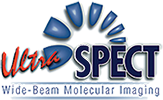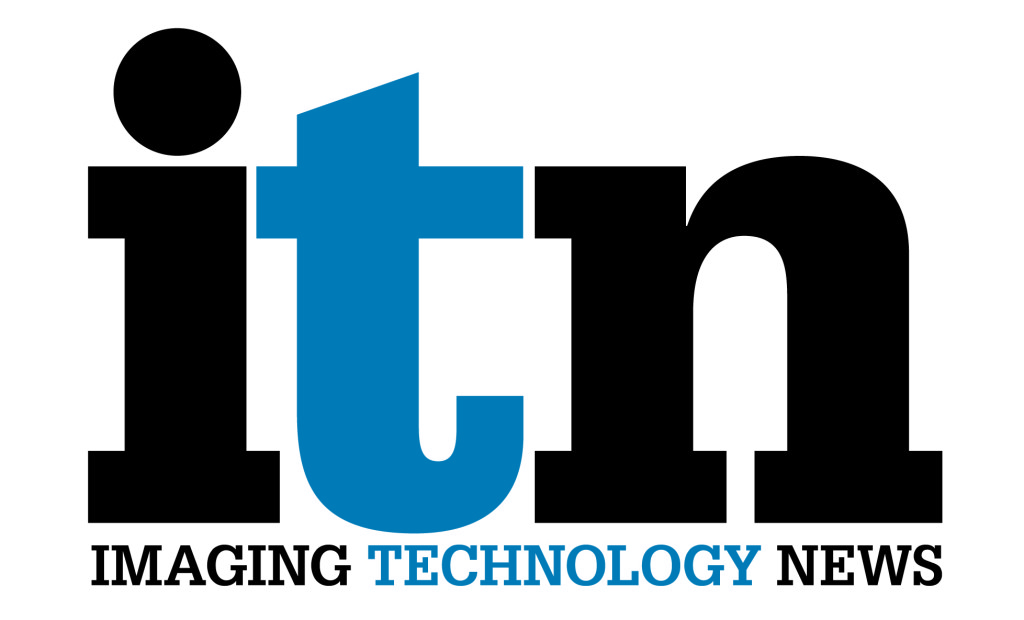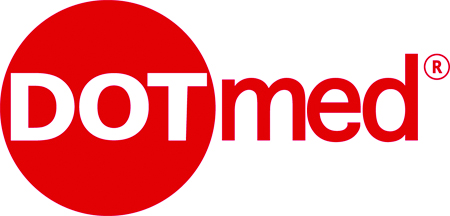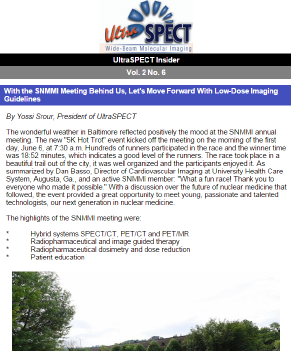 The 2015 SNMMI Meeting a Success
The 2015 SNMMI Meeting a Success
By Yossi Srour, President of UltraSPECT
With the SNMMI Meeting Behind Us, Let’s Move Forward With Low-Dose Imaging Guidelines
The wonderful weather in Baltimore reflected positively the mood at the SNMMI annual meeting. The new "5K Hot Trot" event kicked off the meeting on the morning of the first day, June 6, at 7:30 a.m. Hundreds of runners participated in the race and the winner time was 18:52 minutes, which indicates a good level of the runners. The race took place in a beautiful trail out of the city, it was well organized and the participants enjoyed it. As summarized by Dan Basso, Director of Cardiovascular Imaging at University Health Care System, Augusta, Ga., and an active SNMMI member: "What a fun race! Thank you to everyone who made it possible." With a discussion over the future of nuclear medicine that followed, the event provided a great opportunity to meet young, passionate and talented technologists, our next generation in nuclear medicine.
The highlights of the SNMMI meeting were:
- Hybrid systems SPECT/CT, PET/CT and PET/MR
- Radiopharmaceutical and image guided therapy
- Radiopharmaceutical dosimetry and dose reduction
- Patient education
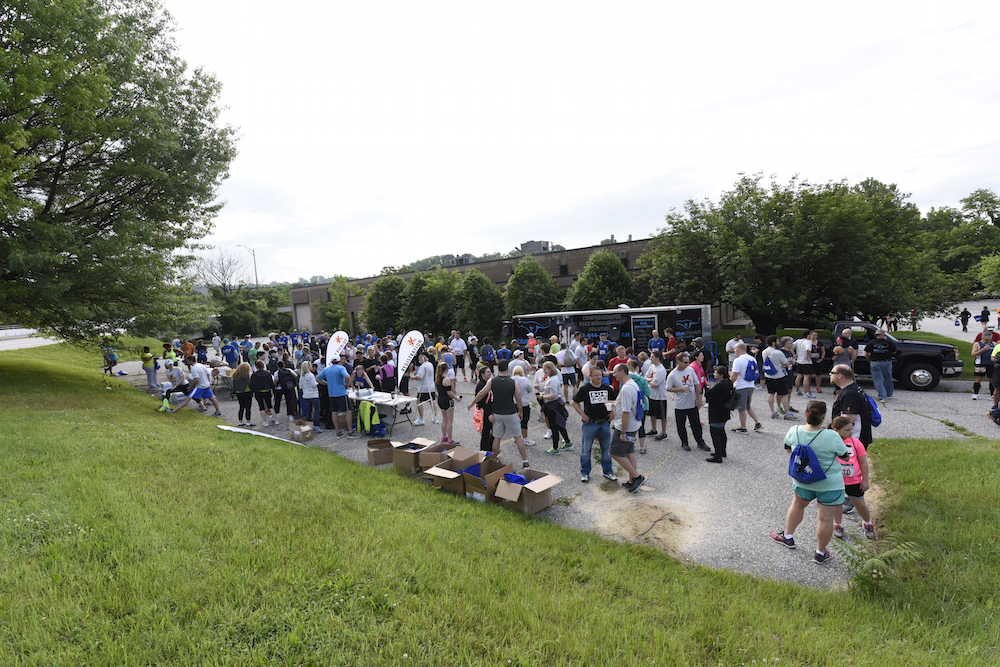
The new "5K Hot Trot" event kicked off the SNMMI annual meeting, with hundreds of runners taking part in the race on a beautiful day just outside Baltimore. Photo courtesy of SNMMI.
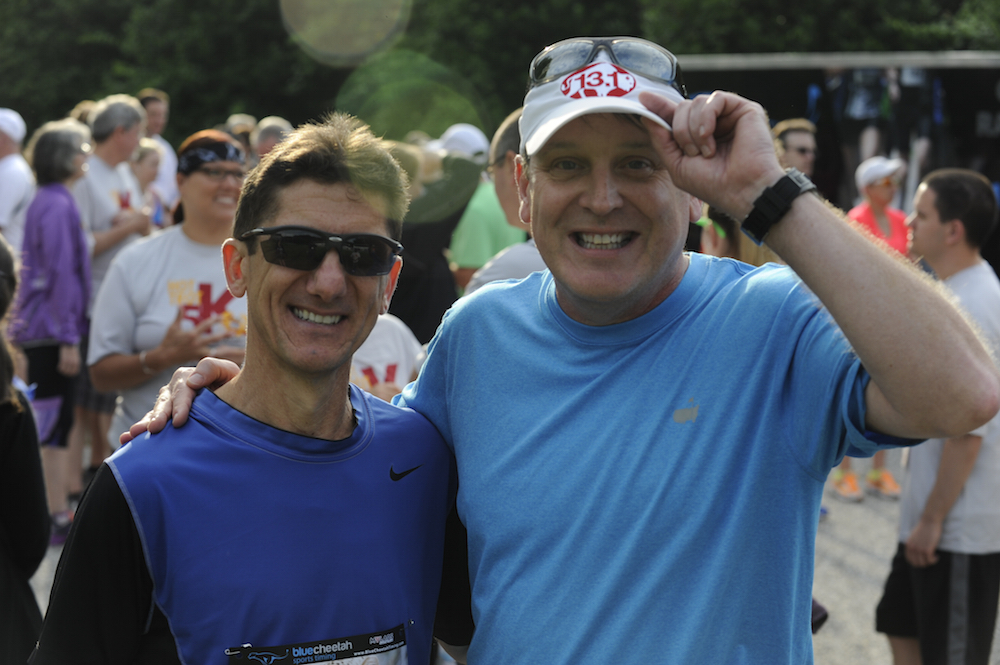
Left to right: Yossi Srour, President of UltraSPECT, and Dan Basso, Director of Cardiovascular Imaging at University Health Care System, Augusta, Ga., at the “5K Hot Trot” run and walk. Photo courtesy of SNMMI.
Although the nuclear medicine research has been making progress with the hybrid systems and new radiotracers, the majority of the market still uses old equipment. The replacement rate is low and, if happens, it is usually only one piece of equipment that is replaced, not the entire department. A typical nuclear medicine department consists of a few different facilities with different equipment from different vendors.
UltraSPECT can play a great role in integrating and bringing the department onto a singular platform with a unified protocol. The solution works with all cameras and workstations, regardless of type, age or workflow practice, allowing for a unified reduced-dose and shortened-time protocol to be used. UltraSPECT's low-dose solution can reduce radiation exposure by over 50 percent – something that physicians and technologists can get behind, for the sake of both their patients and themselves.
Overall, the conversations at the SNMMI meeting indicated that, although dosimetry and dose reduction have been given a lower priority in terms of research, they remain among the most important challenges for the society, that is looking to promote the low-dose imaging guidelines by educating patients, technologists and even patients. UltraSPECT technology can definitely help in the adaptation of the guidelines by the market.
We are excited for the good things to come and are willing to help in any way we can!
Best regards,
Yossi
UltraSPECT in the News
“Managing Dose in PET and SPECT Myocardial Perfusion Imaging”
Imaging Technology News April 20, 2015
“Nuclear Medicine Increasing Patient Safety at a Lower Cost”
DOTmed HealthCare Business News June 2015
Five Questions With Regina Druz, MD
 Dr. Druz is the founder of Integrative Cardiology Center of Long Island. She is also the CEO and co-founder of iVisitMD, Inc. A board certified cardiologist, Dr. Druz is the former director of nuclear cardiology at North Shore LIJ Health system in Manhasset, NY, where she conducted research with UltraSPECT.
Dr. Druz is the founder of Integrative Cardiology Center of Long Island. She is also the CEO and co-founder of iVisitMD, Inc. A board certified cardiologist, Dr. Druz is the former director of nuclear cardiology at North Shore LIJ Health system in Manhasset, NY, where she conducted research with UltraSPECT.
Q: How did you develop your interest in nuclear cardiology (NC)?
A: I was fortunate to work with Dr. Rory Hachamovitch, who was then a director of a NC lab at Weill Medical College at Cornell. Dr. Hachamovitch had a significant interest in cardiac imaging and was involved in outcomes research. I was a second year fellow in the clinical program at that time.
Dr. Hachamovitch and I were reading a SPECT scan on a patient who had a lot of gastro-intestinal attenuation artifact. I suggested that if patients like this could be given the medication used to help some diabetic patients expedite their gastric clearance, perhaps this could help with the image quality. That specific medication had a warning, advising caution in heart patients due to propensity to induce arrhythmias. Dr. Hachamovitch said it was a terrible idea and it would never work! A few days later, however, he came back and said he had looked into it and wanted to design a study to see if the idea might work. He brought me onboard even though I had no research background. The medication worked in a small number of patients and I was chosen to present the results of the study during a Young Investigator Competition at the American Society of Nuclear Cardiology meeting, and the rest, as they say, is history.
Q: Why is low dose needed in NC?
A: In speaking about low dose, it is important to understand the current NC environment. There is a lot of public awareness that certain cardiac procedures have undesirable effects, such as radiation exposure, intravenous contrast, or that they are invasive in nature. There are a lot of regulatory and financial pressures in cardiac imaging right now as we are transitioning from a fee-for-service to value-based model of care.
The more we educate people about why and how we can deliver NC testing in the safest way possible, the better it is for the NC industry. It is critical to engage patients and demonstrate value in cardiac imaging. Part of that value comes from communicating that side effects are as minimal as possible. That’s where low dose comes into play.
If I can say to my patients that the radiation exposure is going to be the least that we can possibly achieve thanks to a new technology, then it will be very valuable in allowing cardiac imaging to continue providing its tremendous contribution for patient care.
Q: When and how did you start to work with UltraSPECT? Tell us about your research with the organization.
A: I began working with UltraSPECT around 2007- 2008. As I became involved in the ASNC, I heard about new technologies that enabled us to lower dose and decrease scan time. I learned more about the wide beam reconstruction (WBR) algorithm that was promising to radically change how we deliver myocardial perfusion imaging.
I decided to evaluate the technology in a real-life setting and ran a trial, which was published in 2010. The trial evaluated the WBR and the initial UltraSPECT algorithm in a diverse group of cardiac patients who were all undergoing myocardial perfusion imaging for clinical indications. What we learned was that UltraSPECT delivered higher quality images that were acquired in ½ the time and with lower dose. This was how we embarked on implementing it in the lab.
We then went one step further and, as other technologies were emerging, we compared the new solid state detectors to older model, standard detectors outfitted with the second generation of the UltraSPECT software, Xpress3.cardaic. We concluded that UltraSPECT had the same high image quality, with the added benefit of allowing us to use our standard 90-degree dual-headed configuration on the nuclear camera, which was more accommodating to overweight or obese patients, with a reduced tracer amount in a shorter period of time. The study was presented at the American College of Cardiology (ACC) and ASNC meetings and was an important milestone for the lab at that time. It allowed us to provide better care for every patient and with the least amount of radiation while maintaining excellent diagnostic quality. We truly managed to fit every patient’s needs, and satisfied the ASNC mandate to reduce exposure to 9mSv or less not in recommended 50% but nearly 100% of our studies!
Q: Is there anything that you perceive as a barrier to adoption of low-dose image-reconstruction techniques in the industry?
A: Every new technology or development in an established field is almost always met initially with some hesitation. There is energy that is required to learn and implement a new solution. For a new technology to prove its value, it needs not only a scientific validation but also internal champions at the place where it will be implemented. They have to be passionate about it and try it in a way that allows it to work. A lot of it has to do with awareness and education.
Today, it is critical for cardiac imaging centers to implement a low dose imaging solution. And to do so effectively, they need to have champions, have research, and have the right structure and process.
Q: Tell us about your recent career switch and the move to start iVisit MD. Why this and why now?
A: My new endeavor actually has a close connection to Nuclear Cardiology. Over the course of my career, I interacted with hundreds, if not thousands, of patients who were referred to me for myocardial perfusion imaging or a regular type of stress test. A lot of these patients did not have a way to reach a cardiologist or a specialist, and so they were assessed by an internal medicine physician without any specialist work-up. As such, many of the prescribed tests were unnecessary, redundant and sometimes inappropriately ordered.
Moreover, when observation care became a reality, we had to accommodate patient populations who were coming into the Emergency Department, and execute stress testing in a very short period of time. Observation care takes place in the hospital but does not necessitate a patient to stay for two consecutive midnights, so there was a clock cut-off on when these patients had to be discharged.
Many patients coming to the ED with cardiac complaints were actually not high on the risk scale and I could have seen them on an outpatient basis. When I asked them why they chose to come to the ED, I expected the most common answer to be, “I had chest pain and thought I was having a heart attack.” Instead, the most common answer turned out to be, “I had chest pain, and I didn’t have a doctor to call or see.” Many of these patients were young and some didn’t have a primary care physician.
When I asked patients if they would like to have a way to get in touch with a doctor rapidly to check their symptoms to see if they needed to go to the ER, they asked, “Where is this system that can check my symptoms? We are going to use it.”
But like every founder, I have a personal story to tell. You will be able to see it soon on the ivisitmd.com in My Story section.
This was the beginning of iVisitMD. Today, the program is in its beta version and is designed to help patients with acute symptoms to address their sense of urgency and get access to the healthcare system – rapidly – while also letting them select providers by the geographic location and insurance coverage. The product is being evaluated in several pilot studies, which will be presented at the ACC annual meeting in March 2016.
UltraSPECT: An exciting endeavor! We wish Dr. Druz well with the iVisitMD pilots!
